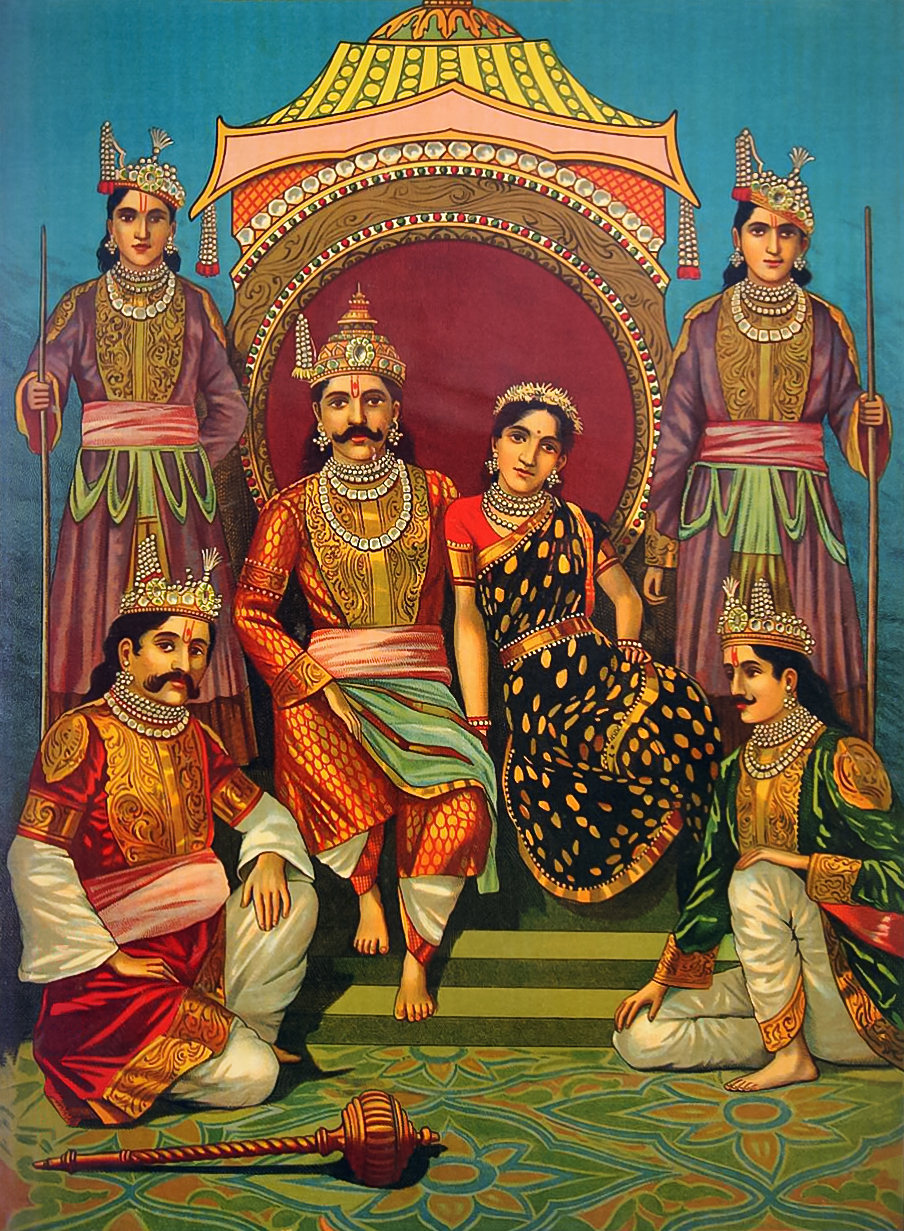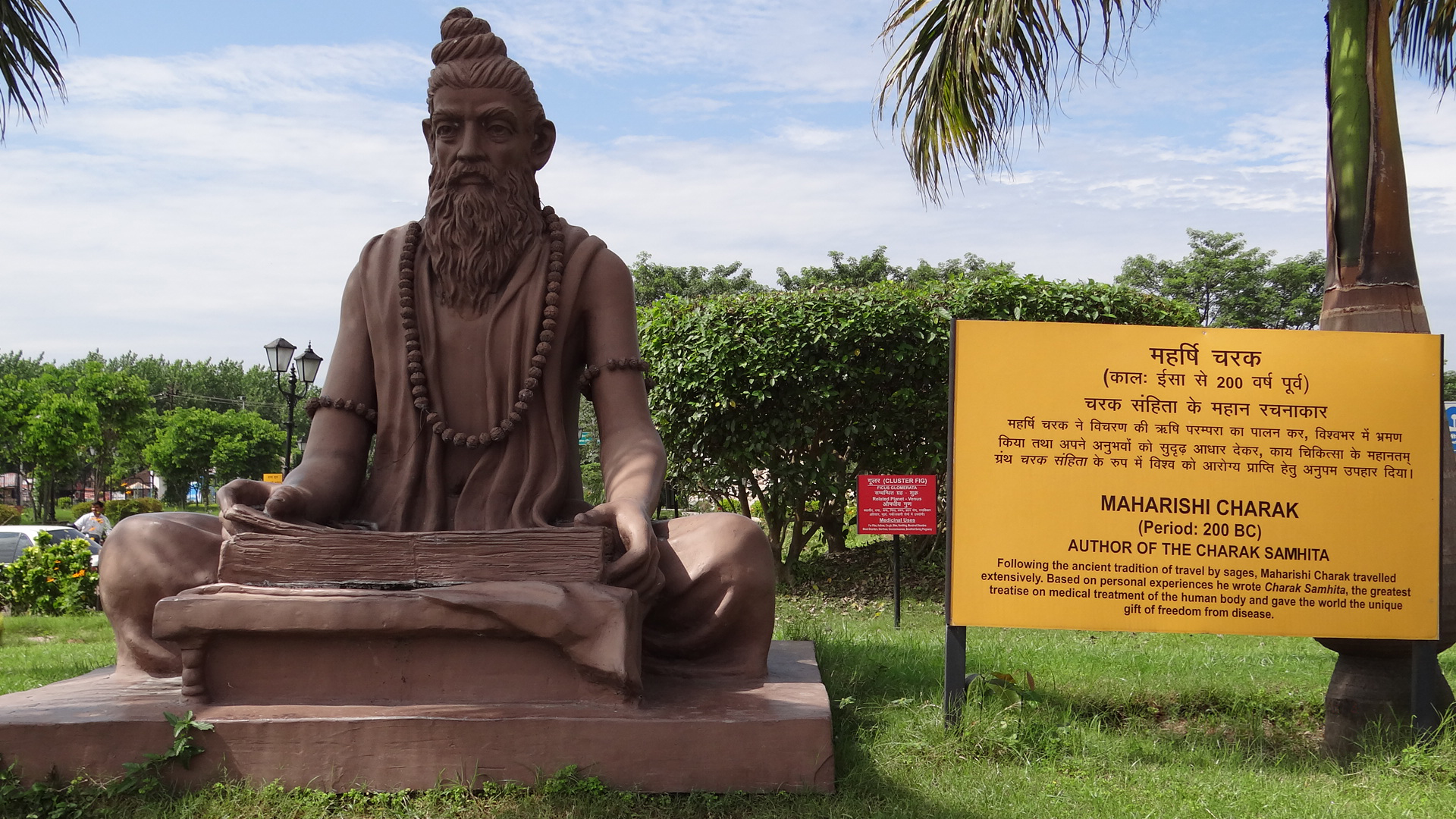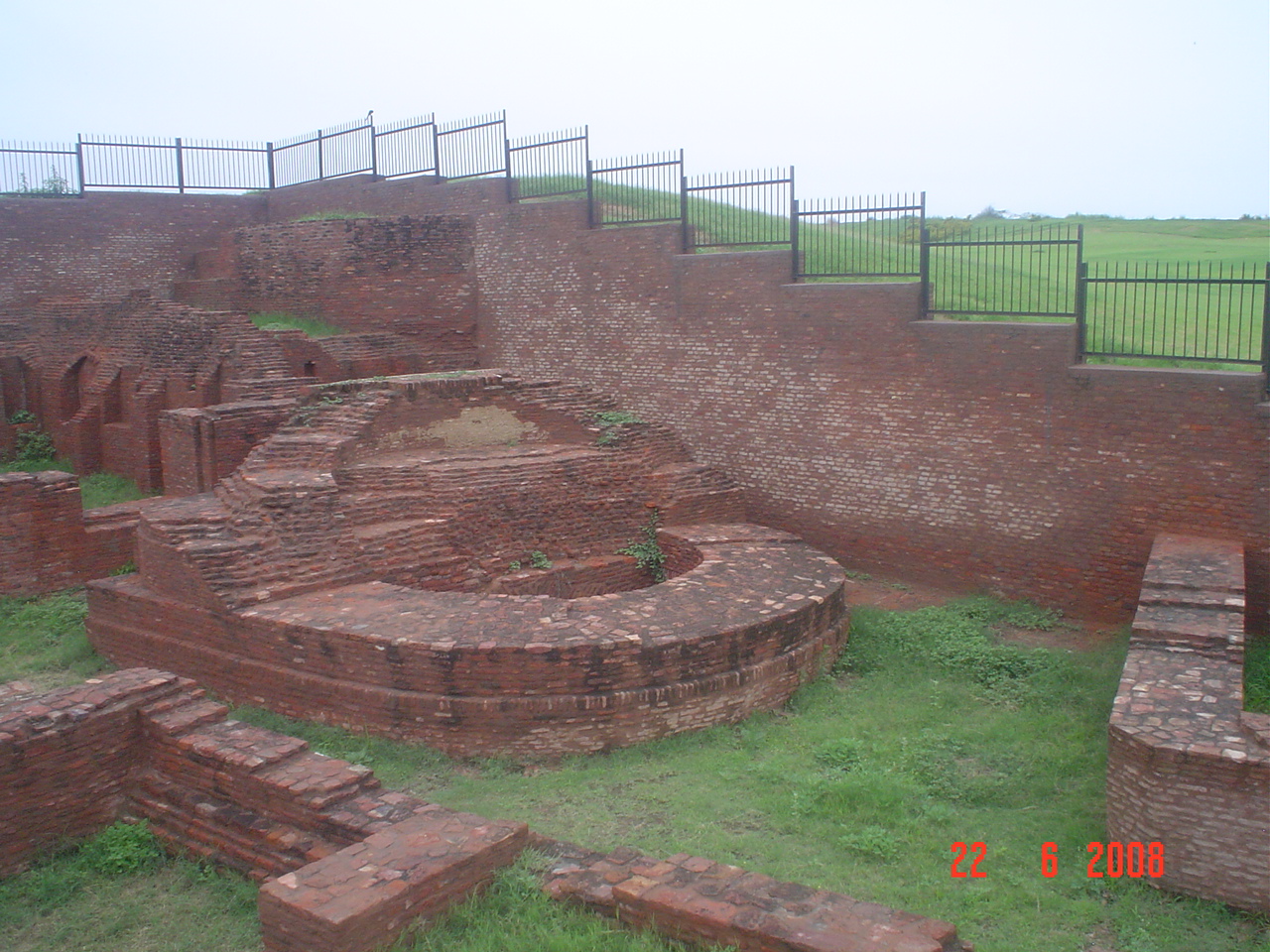|
Parikṣit
Parīkṣit (, ) was a Kuru king who reigned during the Middle Vedic period (12th–9th centuries BCE). Along with his son and successor, Janamejaya, he played a decisive role in the consolidation of the Kuru state, the arrangement of Vedic hymns into collections, and the development of the orthodox srauta ritual, transforming the Kuru realm into the dominant political and cultural center of northern Iron Age India. He also appears as a figure in later legends and traditions. According to the legendary accounts in Mahabharata and the Puranas, he succeeded his granduncle Yudhishthira to the throne of Hastinapur. Introduction "Listen to the good praise of the King belonging to all people, who, (like) a god, is above men, (listen to the praise) of Parikṣit! - 'Parikṣit has just now made us peaceful dwelling; darkness has just now run to its dwelling.' The Kuru householder, preparing (grains) for milling, speaks (thus) with his wife. — 'What shall I bring you, sour milk, t ... [...More Info...] [...Related Items...] OR: [Wikipedia] [Google] [Baidu] |
Janamejaya
Janamejaya () was a Kuru king who reigned during the Middle Vedic period. Along with his father and predecessor Parikshit, he played a decisive role in the consolidation of the Kuru state, the arrangement of Vedic hymns into collections, and the development of the orthodox srauta ritual, transforming the Kuru realm into the dominant political and cultural part of northern India. He also appears as a figure in later legends and traditions, the Mahabharata and the Puranas. Etymology The name ''Janamejaya'' means "man-impelling" or "victorious from birth". In Vedic literature The '' Aitareya Brāhmaṇa'' states that he was a great conqueror and that his '' purohita'' (family priest) Tura Kāvaṣeya consecrated him as king and officiated his '' aśvamedha'' (horse sacrifice). It also states that at one of his sacrifices he did not employ the Kaśyapas as priests but rather the Bhūtavīras. It states that the Asitamr̥ga family of Kaśyapas were eventually reemployed by Ja ... [...More Info...] [...Related Items...] OR: [Wikipedia] [Google] [Baidu] |
Shuka
Shuka ( , also Shukadeva ) is a rishi (sage) in Hinduism. He is the son of the sage Vyasa and the main narrator of the scripture ''Bhagavata Purana''. Most of the ''Bhagavata Purana'' consists of Shuka reciting the story to the king Parikshit in his final days. Shuka is depicted as a sannyasi, renouncing the world in pursuit of moksha (liberation), which most narratives assert that he achieved. Legends Birth According to the Hindu epic ''Mahabharata'', after one hundred years of austerity by Vyasa, Shuka was churned out of a stick of fire, born with ascetic power and with the Vedas dwelling inside him, just like his father. As per ''Skanda Purana'', Vyasa had a wife, Vatikā (also known by the name Pinjalā), daughter of a sage named Jābāli. Their union produced a son, who repeated everything what he heard, thus receiving the name Shuka (lit. Parrot).Skanda Purāṇa, Nāgara Khanda, ch. 147 Other texts including the ''Devi Bhagavata Purana'' also narrate the birth of Shuka ... [...More Info...] [...Related Items...] OR: [Wikipedia] [Google] [Baidu] |
Mahabharata
The ''Mahābhārata'' ( ; , , ) is one of the two major Sanskrit Indian epic poetry, epics of ancient India revered as Smriti texts in Hinduism, the other being the ''Ramayana, Rāmāyaṇa''. It narrates the events and aftermath of the Kurukshetra War, a war of succession between two groups of princely cousins, the Kauravas and the Pandava, Pāṇḍavas. It also contains Hindu philosophy, philosophical and devotional material, such as a discussion of the four "goals of life" or ''puruṣārtha'' (12.161). Among the principal works and stories in the ''Mahābhārata'' are the ''Bhagavad Gita'', the story of Damayanti, the story of Shakuntala, the story of Pururava and Urvashi, the story of Savitri and Satyavan, the story of Kacha (sage), Kacha and Devayani, the story of Rishyasringa and an Ramopakhyana, abbreviated version of the ''Rāmāyaṇa'', often considered as works in their own right. Traditionally, the authorship of the ''Mahābhārata'' is attributed to Vyasa, Vy ... [...More Info...] [...Related Items...] OR: [Wikipedia] [Google] [Baidu] |
Pandava
The Pandavas (Sanskrit: पाण्डव, aɳɖɐʋᵊ IAST: Pāṇḍava) is a group name referring to the five legendary brothers, Yudhishtira, Bhima, Arjuna, Nakula, and Sahadeva, who are central figures of the Hindu epic ''Mahabharata''. They are acknowledged as the sons of Pandu, the King of Kuru, but were fathered by different '' Devas'' (gods) due to Pandu's cursed inability to naturally sire children. In the epic, the Pandavas married Draupadi, the princess of Panchala, and founded the city of Indraprastha after the Kuru Kingdom was split to avoid succession disputes. After the split, the other part of the kingdom was ruled by their cousins, the Kauravas. However, the Pandavas lost their kingdom to Duryodhana (eldest and king of the Kauravas) when Yudhishthira gambled it away during a game of dice. The bet Yudhishtira agreed to was that the Pandavas would hand the kingdom over to the Kauravas and go into exile for 12 followed by an year in hiding. After this ... [...More Info...] [...Related Items...] OR: [Wikipedia] [Google] [Baidu] |
Kurukshetra War
The Kurukshetra War (), also called the Mahabharata War, is a war described in the Hindu Indian epic poetry, epic poem ''Mahabharata'', arising from a dynastic struggle between two groups of cousins, the Kauravas and the Pandavas, for the throne of Hastinapura. The war is used as the context for the dialogues of the ''Bhagavad Gita. Background The ''Mahābhārata'' is an account of the life and deeds of several generations of a ruling dynasty called the Kuru (Hindu mythology), Kuru clan. Central to the epic is an account of a war that took place between two rival families belonging to this clan. Kurukshetra (literally "Kshetram, Region of the Kurus"), also known as Dharmakshetra (the "Region of Dharma"), was the battleground on which the Kurukshetra War was fought. The first ''Mahābhārata'' says that this site was chosen because a sin committed on land was forgiven because of the land's sanctity. The events of the war make up more than a quarter of the ''Mahabharata''. The ... [...More Info...] [...Related Items...] OR: [Wikipedia] [Google] [Baidu] |
Madra Kingdom
Madra kingdom (; ) was a kingdom grouped among the western kingdoms in the Indian epic poetry, ancient Indian epic ''Mahabharata''. Its capital was Sagala in the Madra region. The Kuru (kingdom), Kuru king Pandu's (''Pāṇḍu'') second wife was from Madra kingdom and was called Madri (; ; Help:IPA/Sanskrit, IPA/Sanskrit: ). The Pandava twins, Nakula and Sahadeva, were her sons. Madri's brother Shalya was the king of Madra. Though affectionate to the Pandavas, he was tricked to give support to Duryodhana and fought against the Pandavas during the Kurukshetra War. He was killed by Yudhishthira, the eldest Pandava. Other than the Madra kingdom (Eastern Madra or Purva Madra) with Sagala as its capital, it is believed that there was a Western Madra (Apara Madra) and a Northern Madra (Uttara Madra). Origin According to the Vayu Purana, the Madra kingdom was founded by King Ushinara Shibi of the Anu race. Anu was the son of Yayati. According to Bhagavata Purana, The kingdom of Mad ... [...More Info...] [...Related Items...] OR: [Wikipedia] [Google] [Baidu] |
Atharvaveda
The Atharvaveda or Atharva Veda (, , from ''wikt:अथर्वन्, अथर्वन्'', "priest" and ''wikt:वेद, वेद'', "knowledge") or is the "knowledge storehouse of ''wikt:अथर्वन्, atharvans'', the procedures for everyday life".Laurie Patton (2004), "Veda and Upanishad," in ''The Hindu World'' (Editors: Sushil Mittal and Gene Thursby), Routledge, , page 38 The text is the fourth Veda, and is a late addition to the Vedic scriptures of Hinduism.Laurie Patton (1994), ''Authority, Anxiety, and Canon: Essays in Vedic Interpretation,'' State University of New York Press, , page 57 The language of the Atharvaveda is different from Rigvedic Sanskrit, preserving pre-Vedic Indo-European archaisms. It is a collection of 730 Music of India#History, hymns with about 6,000 mantras, divided into 20 books.Maurice Bloomfield''The Atharvaveda'' Harvard University Press, pages 1-2 About a sixth of the Atharvaveda texts adapt verses from the Rigveda, and exce ... [...More Info...] [...Related Items...] OR: [Wikipedia] [Google] [Baidu] |
Sacred Books Of The East
The ''Sacred Books of the East'' is a monumental 50-volume set of English translations of Asian religious texts, edited by Max Müller and published by the Oxford University Press between 1879 and 1910. It incorporates the essential sacred texts of Hinduism, Buddhism, Taoism, Confucianism, Zoroastrianism, Jainism, and Islam. All of the books are in the public domain in the United States, and most or all are in the public domain in many other countries. Electronic versions of all 50 volumes are widely available online. References External links {{wikisource, Sacred Books of the East, ''Sacred Books of the East''''Sacred Books of the East'' on archive.org (html) [...More Info...] [...Related Items...] OR: [Wikipedia] [Google] [Baidu] |
Haryana
Haryana () is a States and union territories of India, state located in the northern part of India. It was carved out after the linguistic reorganisation of Punjab, India, Punjab on 1 November 1966. It is ranked 21st in terms of area, with less than 1.4% () of India's land area. The state capital is Chandigarh, which it shares with the neighbouring state of Punjab; the most populous city is Faridabad, a part of the National Capital Region (India), National Capital Region. The city of Gurgaon is among India's largest financial and technology hubs. Haryana has Divisions of Haryana, administrative divisions, List of districts of Haryana, districts, 72 sub-divisions, 93 tehsil, revenue tehsils, 50 sub-tehsils, 140 Community development block in India, community development blocks, 154 List of cities in Haryana by population, cities and towns, 7,356 villages, and 6,222 Gram panchayat, villages panchayats. Haryana contains 32 special economic zones (SEZs), mainly located within the ... [...More Info...] [...Related Items...] OR: [Wikipedia] [Google] [Baidu] |
Assandh
Assandh, historically known as Āsandīvat, is a town and a municipal committee in Karnal district in the state of Haryana, India. Assandh is located in 45 km south-west of Karnal. History Early history Archaeological excavations have revealed Painted Grey Ware, associated with the Vedic people of Iron Age India. Assandh is identified with ancient Āsandīvat, a capital of the Kuru Kingdom, which was the first recorded state in Ancient India, . Historian Charles Allen has related this town and the Stupa to the Asandhiwat Kingdom from which hailed Asandhimitra, the Chief Empress (''Agramahisi'') of the Maurya Emperor Ashoka. Assandh Stupa The ruins of more-than-2000-year-old Buddhist stupa is situated at Assandh. The stupa is 25-metre high and at least 75 metres in diameter raised on an earthen platform. It is built with the help of bricks. This stupa is bigger than the much-famous stupa at Sanchi. According to historians, bricks used to construct this stupa, hav ... [...More Info...] [...Related Items...] OR: [Wikipedia] [Google] [Baidu] |







